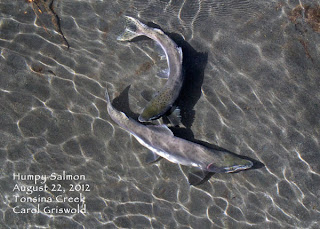Seward
Sporadic Bird Report
"Let's
go find something," I commented to the Good Dog and stepped outside,
camera and binos in hand. Immediately, I heard the excited squawking of
STELLER'S JAYS and BLACK-BILLED MAGPIES, up to something. I headed across the street
to the spruce trees at the edge of the mountainside. Up to something for sure,
but what?
Then
I spied a small brown raptor flying from one branch to another, through the
trees, chased then chasing the Corvids. Finally, it perched in view and I saw
it was a SHARP-SHINNED HAWK. The reprieve didn't last long. The fracas continued for several
minutes with silent jays flying away while others flew in. It seemed more like
a game for the jays and magpies than a breakfast opportunity for the hawk. The
Good Dog lay down, patiently waiting for the real morning walk to begin, so I
reluctantly stopped and off we went. A great start to another beautiful day.
Shortly
after 5 pm, I heard a sharp, high mewing sound. I looked around for raptors.
Amazingly, there were two MERLINS chasing each other around the neighbor's
house and mine, alternately resting alertly in the spruce trees, then dashing
off again. It was incredible to watch their bursts of speed, banking steeply to
vertical then diving down, only a few feet apart and in synchrony. Their
unexpected appearances, swift flight, and erratic swerves were also very hard
to follow with the camera!
Singly,
they dove at jays and pigeons dining at the neighbor's bird feeder, and missed
every time. I watched a STELLER'S JAY fly quickly around and around and around
a cottonwood trunk like a drunken tether-ball while the MERLIN watched from its
perch on a leafy branch several yards above. Maybe they both got dizzy, but at
any rate, nothing happened. Other than that, it seemed the magpies and jays
generally ignored the Merlins, even casually taking a drink at the birdbath in
plain sight, and continuing to grab a bite to eat from the feeder.
I
watched one Merlin rest on a spruce branch. It looked all around, up and down,
forwards and back, constantly on guard, watching for trouble. This bird was
100% engaged and totally alive, every molecule of its being engaged in the present
and focused on survival. It's not easy being a raptor!
Unfortunately,
I could not watch as long as I wanted, but I feel really lucky to have gotten a
glimpse into their intense lives.
Happy
Birding!
Carol
Griswold
Sporadic
Bird Report Reporter























































